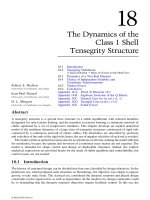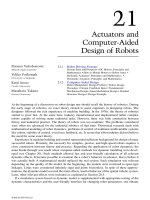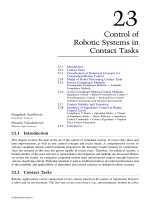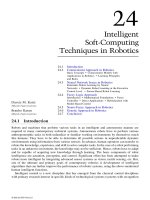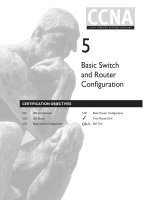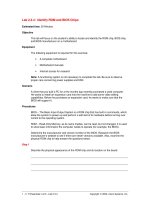Tài liệu Modeling, Measurement and Control P31 doc
Bạn đang xem bản rút gọn của tài liệu. Xem và tải ngay bản đầy đủ của tài liệu tại đây (428.02 KB, 16 trang )
MECHANICAL
SYSTEMS
DESIGN
HANDBOOK
THE
Modeling, Measurement,
and Control
© 2002 by CRC Press LLC
The Electrical Engineering Handbook Series
Series Editor
Richard C. Dorf
University of California, Davis
Titles Included in the Series
The Avionics Handbook, Cary R. Spitzer
The Biomedical Engineering Handbook, 2nd Edition, Joseph D. Bronzino
The Circuits and Filters Handbook, Wai-Kai Chen
The Communications Handbook, Jerry D. Gibson
The Control Handbook, William S. Levine
The Digital Signal Processing Handbook, Vijay K. Madisetti & Douglas Williams
The Electrical Engineering Handbook, 2nd Edition, Richard C. Dorf
The Electric Power Engineering Handbook, Leo L. Grigsby
The Electronics Handbook, Jerry C. Whitaker
The Engineering Handbook, Richard C. Dorf
The Handbook of Formulas and Tables for Signal Processing, Alexander D. Poularikas
The Industrial Electronics Handbook, J. David Irwin
The Measurement, Instrumentation, and Sensors Handbook, John G. Webster
The Mechanical Systems Design Handbook, Osita D.I. Nwokah
The RF and Microwave Handbook, Mike Golio
The Mobile Communications Handbook, 2nd Edition, Jerry D. Gibson
The Ocean Engineering Handbook, Ferial El-Hawary
The Technology Management Handbook, Richard C. Dorf
The Transforms and Applications Handbook, 2nd Edition, Alexander D. Poularikas
The VLSI Handbook, Wai-Kai Chen
The Mechatronics Handbook, Robert H. Bishop
The Computer Engineering Handbook, Vojin Oklobdzija
Forthcoming Titles
The Circuits and Filters Handbook, 2nd Edition, Wai-Kai Chen
The Handbook of Ad hoc Wireless Networks, Mohammad Ilyas
The Handbook of Optical Communication Networks, Mohammad Ilyas
The Handbook of Nanoscience, Engineering, and Technology, William A. Goddard,
Donald W. Brenner, Sergey E. Lyshevski, and Gerald J. Iafrate
© 2002 by CRC Press LLC
CRC PRESS
Boca Raton London New York Washington, D.C.
OSITA D. I. NWOKAH
YILDIRIM HURMUZLU
Southern Methodist University
Dallas, Texas
MECHANICAL
SYSTEMS
DESIGN
HANDBOOK
THE
Modeling, Measurement,
and Control
This book contains information obtained from authentic and highly regarded sources. Reprinted material is quoted with
permission, and sources are indicated. A wide variety of references are listed. Reasonable efforts have been made to publish
reliable data and information, but the authors and the publisher cannot assume responsibility for the validity of all materials
or for the consequences of their use.
Neither this book nor any part may be reproduced or transmitted in any form or by any means, electronic or mechanical,
including photocopying, microfilming, and recording, or by any information storage or retrieval system, without prior
permission in writing from the publisher.
All rights reserved. Authorization to photocopy items for internal or personal use, or the personal or internal use of specific
clients, may be granted by CRC Press LLC, provided that $1.50 per page photocopied is paid directly to Copyright Clearance
Center, 222 Rosewood Drive, Danvers, MA 01923 USA The fee code for users of the Transactional Reporting Service is
ISBN 0-8493-8596-2/02/$0.00+$1.50. The fee is subject to change without notice. For organizations that have been granted
a photocopy license by the CCC, a separate system of payment has been arranged.
The consent of CRC Press LLC does not extend to copying for general distribution, for promotion, for creating new works,
or for resale. Specific permission must be obtained in writing from CRC Press LLC for such copying.
Direct all inquiries to CRC Press LLC, 2000 N.W. Corporate Blvd., Boca Raton, Florida 33431.
Trademark Notice:
Product or corporate names may be trademarks or registered trademarks, and are used only for
identification and explanation, without intent to infringe.
Visit the CRC Press Web site at www.crcpress.com
© 2002 by CRC Press LLC
No claim to original U.S. Government works
International Standard Book Number 0-8493-8596-2
Library of Congress Card Number 2001043150
Printed in the United States of America 1 2 3 4 5 6 7 8 9 0
Printed on acid-free paper
Library of Congress Cataloging-in-Publication Data
The Mechanical systems design handbook : modeling, measurement, and control / edited
by Osita D.I. Nwokah, Yildirim Hurmuzlu.
p. cm. -- (The Electrical engineering handbook series)
Includes bibliographical references and index.
ISBN 0-8493-8596-2 (alk. paper)
1. Production engineering. 2. Manufacturing processes. I. Nwokah, Osita D. I. II.
Hurmuzlu, Yildirim. III. Series.
TS176 .M42 2001
658.5--dc21
2001043150
8596_frame_FM Page iv Monday, November 12, 2001 1:29 PM
Preface
This handbook is targeted as a reference for the use of engineers and scientists in industry. We have
compiled a collection of selected topics that are directly related to the design and control of mechanical
systems. The main motivation for the book is to present a practical overview of fundamental issues
associated with design and control of mechanical systems. The reader will find four sections in the
handbook: (1) Manufacturing, (2) Vibration Control, (3) Aerospace Systems, and (4) Robotics. Although
the sections are arranged in a certain order, each contribution can stand alone to represent its subject.
Thus, people can read the handbook in any order they see fit.
The late Professor Osita Nwokah envisioned this project. Unfortunately, he could not see it through
to completion. Professor Nwokah was the chairman of the mechanical engineering department at South-
ern Methodist University and a distinguished member of the control community when he passed away
on April 20, 1999. It was important to me to finish one of Professor Nwokah’s last projects.
The reader will find a broad range of thoroughly covered important topics by well-known experts in
their respective fields. Section I encompasses control issues related to manufacturing systems including
several topics from precision manufacturing to machine vibrations. Section II deals with active vibration
control including a diverse spectrum of topics such as suspension systems and piezoelectric networks.
Section III touches upon aerospace systems, and the authors have presented a detailed analysis of
tensegrity structures. Section IV covers robotics and is an encyclopedic review of most issues related to
the control and design of robotic systems.
It has been a pleasure to work with the four section editors, each a renowned international expert in
his respective area. They, in turn, recruited very competent people who wrote chapters that, in my view,
are individually important contributions to the design and control of mechanical systems. I also thank
the people at CRC Press whose energy and constant support were essential to the completion of this
handbook. I especially thank Nora Konopka who has spent numerous hours developing and producing
this handbook.
Yildirim Hurmuzlu
Dallas, Texas
8596_frame_FM Page v Monday, November 12, 2001 1:29 PM
© 2002 by CRC Press LLC
Editors
Yildirim Hurmuzlu
currently serves as the Chairman of the Department of Mechanical Engineering at
Southern Methodist University in Dallas, Texas. He has been with the department since 1987, and has
served as assistant, associate, and full professor. Dr. Hurmuzlu's research interests are in the field of
dynamic systems and controls, with particular emphasis on robotics and biomechanics. His research has
been supported by the National Science Foundation, Whitaker Foundation, and Texas National Labora-
tory Commission, and industrial corporations such as Bell Helicopter, Raytheon, Saudi Aramco, and
Alcatel Corp. He has authored more than 50 articles in journals and conference proceedings and has
organized sessions at national and international conferences.
Dr. Hurmuzlu is an associate editor of the
ASME Journal of Dynamic Systems Measurement and Control
. He has also served as the chairman of
IEEE Dallas–Fort Worth Control Systems Society and the ASME DSC biomechanics panel.
Osita Nwokah
was a leading international authority on the application of multivariable design methods
for the control of high-performance, high-bypass ratio turbomachinery. As a graduate student at the
University of Manchester Institute of Science and Technology (UMIST), Manchester, England, he was a
member of the team that wrote the initial control algorithms for the regulation of the Rolls Royce
Concordce Olympus 925 Engines using the inverse Nyquist array in 1971. After moving to the United
States, Dr. Nwokah continued this line of work and developed fundamental methodologies to combine
the inverse Nyquist array with the quantitative feedback theory (QFT) design method of Horowitz. At
the time of his death, Dr. Nwokah was studying multivariable control design and implementation for
the RASCAL Helicopter for NASA and U.S. Army at NASA Ames RC, Moffet Field, California.
8596_frame_FM Page vii Monday, November 12, 2001 1:29 PM
© 2002 by CRC Press LLC
